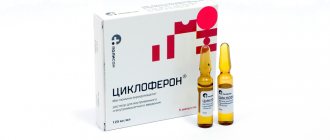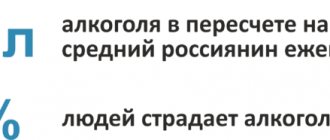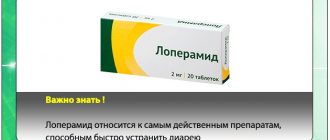Registration number: R N001049/02 dated 12/12/2007 Tradename: CYCLOFERON® (СYCLOFERON®) Dosage form: enteric-coated tablets Group name: meglumine acridone acetate
Composition of the drug Pharmacological properties Indications for use Contraindications
Directions for use and dosage Side effects Interaction with other drugs
Pharmacological properties
Pharmacodynamics
Cycloferon is a low-molecular-weight interferon inducer, which determines a wide range of its biological activity (antiviral, immunomodulatory, anti-inflammatory, etc.). Cycloferon is effective against herpes viruses, influenza and other pathogens of acute respiratory diseases. It has a direct antiviral effect, suppressing viral reproduction in the early stages (days 1–5) of the infectious process, reducing the infectivity of viral offspring, leading to the formation of defective viral particles. Increases the body's nonspecific resistance to viral and bacterial infections.
Pharmacokinetics
When taking a daily dose, the maximum concentration in the blood plasma is reached after 2–3 hours, gradually decreases by the 8th hour, and after 24 hours Cycloferon is detected in trace amounts. The half-life of the drug is 4–5 hours, so its use in recommended doses does not create conditions for accumulation in the body.
Description, composition and release form
Cycloferon is considered a domestically produced medicine. It is produced in several forms:
- tablets for oral administration. Sold in packaging;
- ointment and gel, distinguished by a specific odor. Sold in tubes;
- solution in ampoules.
An antiviral drug can improve the resistance of the human body. The drug has high pharmacological activity. Used to treat viral and bacterial diseases, as well as to strengthen the immune system. Cycloferon has a broad effect. This remedy has been known for several decades. During this time, doctors and patients were able to verify its effectiveness for various diseases.
The main active ingredient is the compound acridoneacetic acid. Additional components include:
- tablets contain: polymers, cellulose, povidones, Ca salts;
- in the form of gels and ointments: meglumines, benzalkonium;
- solution: sterile water, meglumines.
Directions for use and doses
Orally once a day 30 minutes before meals, without chewing, with ½ glass of water, in age-specific dosages:
- children 4–6 years old: 150 mg (1 tablet) per dose;
- children 7–11 years old: 300–450 mg (2–3 tablets) per dose;
- adults and children over 12 years of age: 450–600 mg (3–4 tablets) per dose.
It is advisable to repeat the course 2–3 weeks after the end of the first course.
In adults:
- When treating influenza and acute respiratory diseases, the drug is taken on days 1, 2, 4, 6, 8 (course of treatment - 20 tablets). Treatment should begin at the first symptoms of the disease. For severe flu, take six tablets on the first day. If necessary, additional symptomatic therapy is carried out (antipyretics, analgesics, expectorants).
- For herpes infection, the drug is taken on days 1, 2, 4, 6, 8, 11, 14, 17, 20, 23 (course of treatment - 40 tablets). Treatment is most effective when the first symptoms of the disease appear.
In children from four years of age:
- For influenza and acute respiratory diseases, the drug is taken in age-specific doses on days 1, 2, 4, 6, 8, 11, 14, 17, 20, 23. The course of treatment ranges from 5 to 10 doses, depending on the severity of the condition and the severity of clinical symptoms.
- For herpes infection, the drug is taken on the 1st, 2nd, 4th, 6th, 8th, 11th, 14th day of treatment. The course of treatment may vary depending on the severity of the condition and the severity of clinical symptoms.
- For emergency nonspecific prevention of influenza and acute respiratory diseases (in direct contact with patients with influenza or acute respiratory infections of another etiology, during an influenza epidemic): on the 1st, 2nd, 4th, 6th, 8th day. Next, take a break of 72 hours (three days) and continue the course on the 11th, 14th, 17th, 20th, 23rd day. The general course is from 5 to 10 doses.
Indications for use
The drug in the form of tablets and solution can be taken for the following conditions:
- ARVI;
- herpes;
- Lyme disease;
- secondary immunodeficiency;
- candidiasis of various etiologies;
- condylomas;
- serous meningitis.
This is not the entire list of diseases for which Cycloferon helps. Only a doctor can prescribe medication after examination and diagnosis.
Children are allowed to take the product from 4 years of age. Indications for use in pediatrics:
- flu;
- hepatitis B and C;
- intestinal infections;
- acute respiratory infections.
Side effects
According to the World Health Organization, adverse effects are classified according to their frequency as follows:
– very frequent (≥ 1/10); – frequent (≥ 1/100 – < 1/10); – uncommon (≥ 1/1000 – < 1/100); – rare (≥ 1/10000 – < 1/1000); – very rare (< 1/10000); – frequency unknown (cannot be determined based on available data). Immune system disorders: very rarely - angioedema. Disorders of the skin and subcutaneous tissues: very rarely - rash, urticaria. If any of the undesirable effects indicated in the instructions get worse or you notice any other undesirable effects not listed in the instructions, tell your doctor.
Pharmacology
The mechanism of action of the drug is as follows:
- takes part in starting the process of phagocytosis;
- accelerates the production of interferon;
- has an antitumor effect;
- prevents the emergence and spread of harmful bacteria;
- eliminates inflammatory processes.
The active substance can penetrate the body's protective barriers, including the circulatory system and brain tissue. The maximum concentration of constituent elements in the blood is achieved after 2.5 hours and persists for 8 hours. The drug is endowed with two main properties - it strengthens the immune system and has an antimicrobial effect. Cycloferon also copes with various allergic and inflammatory reactions.
When used externally, local immunity is also strengthened and skin protection is created. Gels and ointments prevent viral DNA from entering the skin.
Contraindications and adverse reactions
The drug has the following contraindications:
- cirrhosis of the liver;
- pregnancy;
- breastfeeding period;
- thyroid disease;
- children under 4 years old;
- excessive sensitivity to constituent components.
Taking Cycloferon can in rare cases lead to side effects. These include:
- hyperthermia of the skin;
- allergies in the form of redness, rash and itching;
- vomiting and nausea;
- elevated temperature.
If such symptoms are found, then you should stop taking the drug and consult a doctor to select a suitable analogue.
Cycloferon for genital herpes
In addition to systemic therapy, applications with Cycloferon liniment are used:
- a thin layer of the product is applied to the affected areas daily for 5–7 days;
- use the drug for intravaginal or transurethral instillation, injecting 5 ml daily for 2 weeks;
- cotton swabs soaked in ointment are inserted into the vagina for 10–15 days.
Cycloferon ointment can be alternated with the use of other topical drugs.
Contraindications
It is necessary to refuse treatment with the drug:
- with uncompensated cirrhosis;
- severe liver failure;
- individual intolerance to components;
- development of an allergy to the drug.
The medicine is also prohibited for the treatment of children under 4 years of age.
Those suffering from diseases of the gastrointestinal tract need to monitor their well-being when using tablets. In case of disturbances in the functioning of the endocrine system, treatment requires special care and medical supervision.
Basic regimen for taking Cycloferon (table) for colds and flu
The regimen for taking Cycloferon was developed taking into account the characteristics of the human immune system. Cycloferon (table) should be taken once a day, half an hour before meals, with ½ glass of water. At the beginning of treatment, the tablets are taken for two days in a row (days 1, 2), after which it is necessary to take a break for one day and continue taking the drug on the fourth day of treatment. Next, Cycloferon is taken every other day (days 6 and 8 of treatment), without changing the dosage.
The tablets cannot be chewed - they are coated with a special enteric coating designed to transport the active substance through the stomach to the intestines, where the active substance is absorbed and subsequently distributed to areas affected by the viral infection. The destruction of tablets at the time of administration (crushing, resorption, chewing) leads to a decrease in the therapeutic effect.
If the next dose of Cycloferon was missed, then at the first opportunity you should continue the course of treatment according to the basic regimen, every other day, without changing the dosage.
If the necessary break between doses of the drug has not been taken, you should skip 2 days, and then continue taking Cycloferon (table) according to the schedule every other day.
Mechanism of action of Cycloferon
The drug corrects the body's immunity by activating the production of interferons. When administered orally, meglumine is concentrated in the tissues of the liver, spleen, lungs, and intestines, on which the production of lymphocytes depends. Cycloferon also accelerates the release of granulocytes in the bone marrow.
The medicine inhibits autoimmune processes, reducing the body's pathological reaction to rheumatoid arthritis and other systemic diseases, and reduces the body's negative reactions during chemotherapy. When applied topically, the ointment reduces inflammation and has an antiproliferative effect.
The highest concentration of Cycloferon in the body is observed 2.5–3 hours after administration. Over the next 4–5 hours, it decreases by half. Complete elimination of the drug takes 1–1.5 days. The active substance is not deposited in tissues, does not provoke mutation processes, and does not cause intoxication.
Indications
Cycloferon is used in patients from 4 years of age:
- in the treatment of herpetic infections;
- for neuroinfections;
- cytomegalovirus;
- intestinal inflammation of a viral nature;
- for the treatment of acute respiratory viral infections, acute respiratory infections;
- in the complex treatment of viral hepatitis, HIV.
Liniment is used in the treatment of urogenital infections. The solution is also indicated for chlamydia and connective tissue diseases.
Why do doctors recommend using Cycloferon (table)
- Cycloferon has a direct antiviral effect, helping to block the activity of influenza and ARVI viruses.
- It has a wide range of antiviral activity* and is used against various influenza viruses, including influenza viruses type A (H3N2) and (H1N1) - “Hong Kong” and “swine” flu, and other pathogens of acute respiratory diseases, as well as herpes.
- Increases the body's resistance to infectious diseases caused by influenza and ARVI viruses, as it stimulates the activity of its own immunity**.
- Cycloferon has an anti-inflammatory effect.
- Helps reduce the frequency, severity and duration of viral infections, including colds and flu**.
- Cycloferon does not put additional stress on the liver and is almost completely eliminated from the body within a day. Avoiding additional stress on the liver is very important, especially in the case of prescribing antibiotics, which can be used when bacterial complications occur in combination with the main antiviral therapy.
- Does not reduce the therapeutic effect even with frequent use**.
- Compatible with various drugs to relieve symptoms of flu and colds (antipyretic, expectorant, analgesic, etc.).
- Within 2-3 hours from the moment of administration, the maximum concentration of the active substance in the patient’s blood is observed and the antiviral effect of the drug begins.
Due to its properties, Cycloferon is included in the Temporary guidelines “Drug therapy of acute respiratory viral infections (ARVI) in outpatient practice during the COVID-19 epidemic” version 2 dated April 16, 2020, and also as an interferon inducer included in the Temporary guidelines “Prevention, diagnosis and treatment of new coronavirus infection (COVID-19)” version 9 dated October 26, 2020***







